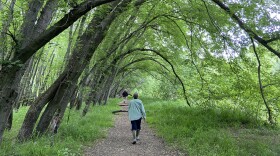Something Wild host Dave Anderson of the Forest Society takes a lot of people on walks through the woods.
Lately, he’s noticed something. “When we walk in the woods, we’re pretty much all about facts, names, data…but have we lost something as adults? Where does imagination come into play?”
Naturalist Susie Spikol at the Harris Center for Conservation Education says imagination is an important part of outdoor education. Her book, Forest Magic for Kids, is about ways of encouraging imaginative play with kids, which she says is a crucial part of connecting with nature.

“We wandered the Harris Center grounds and visited little fairy villages,” says Chris Martin, Something Wild co-host from NH Audubon. “You had to be careful not to step on dwellings – everywhere you look - constructed with twigs, pine cones, sticks, stones, and a lot of imagination!”
Spikol admired the creations: “This one's really got a lot of material. It's got a table with acorn plates. It's got a bed with a blanket of bark. It's got a staircase made out of moss, a mossy piece of bark and a roof, which is very exciting.”
Here’s an edited excerpt of our conversation:
Dave: Do you believe in elves and fairies and woodland folk?
Susie: Of course I do, Dave, I believe in that. And I've been searching for them and looking for them in all the nooks and crannies everywhere I go.
Dave: Do you think adults stop looking for them?
Susie: Yeah, I think a lot of grownups do. I think they forget about the magic that the forest has. And I think that if everybody did spend a little more time thinking about the wild possibility of the natural landscape, they would be a lot happier. And remember the magic of their childhood. I mean, did you look for gnomes? Are you still looking? You're not?
Dave: I'm finding my way back to a place of the ecology of childhood imagination. And I find that being in a forest is conducive to thinking that way. It's kind of hard in the office to look for fairy folk!
Susie: I think maybe when we're outside as grownups, we call it something else. You know, we go into the woods and we feel more relaxed, or we feel in tune with nature, or we feel like we're having this sort of spiritual moment in the natural world, and maybe that's the way we think of it as magic.

Chris: I'd be interested in hearing what your thoughts are on the nexus between imagination and science.
Susie: The book is a real mix of kind of a make-believe in imagination mixed in with the real science behind it.
So when you're reading about fairy circles, which is a ring of mushrooms that grows, the folklore is that they were made by the fairies the night before, who had a big party, and everywhere their foot landed, a mushroom grew the next day.
But really, in the book, it goes on to explain that it's the mycelium of one type of fungi that's underground, and that the mushrooms all kind of bloom at the same time, creating the circle.
Dave: You're saying, nature is a friendly place and it's engaging. Come outside and play and learn.

Susie: When you have kids that feel like, oh, I don't need to catch a frog because I watched it on YouTube, but they never have the experience of actually touching something wild and holding it and then letting it go free.
To me, if we don't let our kids do that, then children are really missing out on a huge part of childhood and a huge part of what makes you fall in love with the natural world.
If we don't have those experiences as children, how can we hope that kids will grow up to want to take care of the natural world, or be outside in it, or even find any kind of enjoyment in it?
Dave: Can you talk about foxfire mushrooms?
Susie: Oh, man. Foxfire mushrooms are magical. They glow in the dark. They're bioluminescent, and they grow along in our woods. And you have to go outside to find them at night. And I remember when I was about 11 years old, I was away at sleepaway camp, and we were on a night hike. And that's the first time I saw foxfire fungus. And it just went right into my heart.
And I am a foxfire fungus searcher. And you can be, too. You just have to go outside. You got to go into the woods. You've got to be brave. And you got to shut your flashlight off, because if you have your flashlight on, you will not see it.
It's very subtle and for a moment you're like, wait, I think I see something glowing. And then you do. And it's glow-in-the-dark mushrooms. What could be crazier than that? More magical? Forest magic is all around us, all around us. Even in the science.
Something Wild is a partnership of the Forest Society, NH Audubon, and NHPR.











